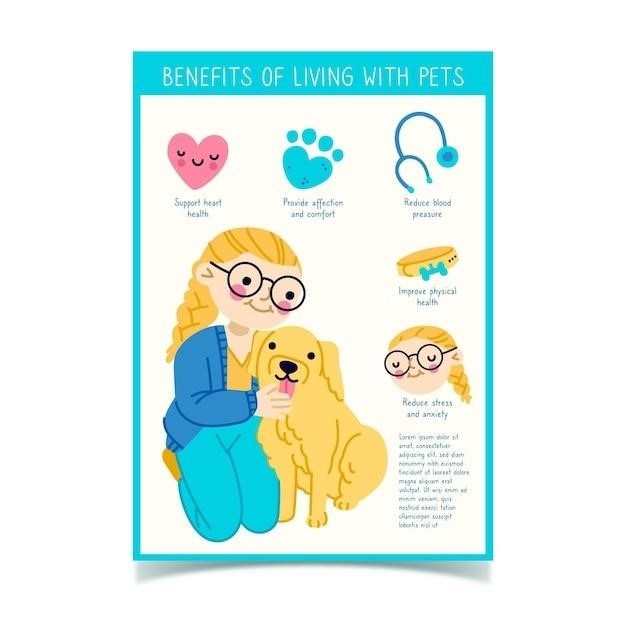Ichthyosis in Golden Retrievers⁚ An Overview
Golden Retriever ichthyosis‚ a genetic skin disorder‚ presents as dry‚ scaly skin resembling fish scales. It’s an autosomal recessive condition‚ requiring inheritance of a mutated gene from both parents. Treatment focuses on managing symptoms‚ not curing the condition.
Genetic Basis of Golden Retriever Ichthyosis
Ichthyosis in Golden Retrievers is primarily attributed to genetic mutations. A significant cause is linked to a mutation in the PNPLA1 gene‚ which encodes a patatin-like phospholipase crucial for lipid metabolism and signaling within the skin. This autosomal recessive inheritance pattern means affected dogs inherit a copy of the mutated gene from each parent. The resulting deficiency in lipid processing leads to impaired skin barrier function‚ manifesting as the characteristic dry‚ scaly skin. While PNPLA1 mutations account for many cases‚ research suggests other genetic factors might contribute to this complex condition‚ potentially explaining variations in severity and clinical presentation. Further genetic research is ongoing to fully elucidate the genetic architecture of Golden Retriever ichthyosis and identify additional genes involved. This deeper understanding promises more accurate diagnostics and potentially targeted therapeutic approaches. Genetic testing is available to confirm diagnosis and aid in breeding decisions to minimize the occurrence of this inherited skin disorder.
Clinical Presentation and Diagnosis
The clinical presentation of Golden Retriever ichthyosis varies in severity. Affected dogs typically exhibit dry‚ scaly skin‚ often described as resembling fish scales. The scales can range in size and color‚ from small and whitish to large and darker. While pruritus (itching) and inflammation are usually absent‚ some dogs may experience mild discomfort. The condition may be generalized‚ affecting the entire body‚ or localized to specific areas. Diagnosis involves a thorough physical examination by a veterinarian‚ focusing on the skin’s appearance and texture. A detailed history‚ including the dog’s breed and family history‚ is crucial. Histopathological examination of skin biopsies can confirm the diagnosis by revealing characteristic features like lamellar orthokeratotic hyperkeratosis and mildly hyperplastic epidermis. Genetic testing for PNPLA1 mutations provides definitive confirmation of the diagnosis‚ differentiating it from other skin conditions with similar presentations. Early and accurate diagnosis allows for timely implementation of appropriate management strategies to minimize discomfort and improve the dog’s quality of life.
Differential Diagnoses for Scaly Skin in Golden Retrievers
Differentiating Golden Retriever ichthyosis from other skin conditions causing scaly skin requires careful consideration. Several dermatological issues can mimic ichthyosis‚ necessitating a comprehensive diagnostic approach. These include various forms of seborrhea‚ characterized by greasy or dry scaling‚ often accompanied by inflammation and odor. Bacterial or fungal infections can also present with scaling‚ potentially accompanied by erythema‚ crusting‚ or hair loss. Allergic dermatitis‚ triggered by environmental allergens or food sensitivities‚ may manifest as scaling and intense itching. Parasitic infestations‚ such as mange‚ can cause significant scaling and inflammation. Endocrine disorders‚ such as hypothyroidism‚ can impact skin health‚ resulting in dryness and scaling. Finally‚ other genetic skin conditions‚ distinct from ichthyosis‚ may present with similar clinical signs. A thorough history‚ physical examination‚ microscopic examination of skin scrapings‚ and possibly allergy testing are crucial to differentiating ichthyosis from these various conditions. Genetic testing specifically for ichthyosis helps to confirm the diagnosis and rule out other possibilities. Accurate differential diagnosis ensures appropriate treatment is selected for the underlying cause of the skin problem.

Treatment Options for Ichthyosis
Ichthyosis treatment in Golden Retrievers primarily focuses on symptom management. This involves regular bathing with medicated shampoos and consistent application of emollients and moisturizers to hydrate the skin and alleviate scaling.
Topical Treatments⁚ Shampoos‚ Emollients‚ and Moisturizers
Topical treatments form the cornerstone of ichthyosis management in Golden Retrievers. Regular bathing with specially formulated shampoos is crucial. These shampoos often contain keratolytic agents to help break down and remove scales‚ and emollients to soften and moisturize the skin. The frequency of bathing will depend on the severity of the condition‚ but it’s generally recommended to bathe the dog several times a week‚ or as directed by your veterinarian. After bathing‚ applying emollients and moisturizers is essential to lock in moisture and prevent further dryness and scaling. These products create a protective barrier‚ helping to reduce water loss from the skin and improve its overall condition. There’s a wide variety of emollients and moisturizers available‚ and your veterinarian can help you choose the best ones for your dog. Look for products that are specifically designed for sensitive skin and free from harsh chemicals or fragrances that could irritate the already compromised skin barrier. Consistency is key; regular application of these products will significantly improve your dog’s comfort and the appearance of their skin. Remember to always follow your veterinarian’s recommendations for the specific products and frequency of application to ensure optimal results. Regular monitoring of your dog’s skin condition and adjustments to the treatment plan as needed are crucial for effective management.
Dietary Supplementation⁚ Fatty Acids and Other Nutrients
Incorporating dietary supplements rich in essential fatty acids‚ particularly omega-3 and omega-6 fatty acids‚ can significantly benefit Golden Retrievers with ichthyosis. These fatty acids play a vital role in maintaining the skin’s barrier function and reducing inflammation. Omega-3s‚ found in fish oil and flaxseed oil‚ have anti-inflammatory properties that can help soothe irritated skin and reduce scaling. Omega-6 fatty acids‚ present in various vegetable oils‚ contribute to the skin’s structural integrity and hydration; The ideal ratio of omega-3 to omega-6 fatty acids should be carefully considered‚ as an imbalance can exacerbate skin issues. Your veterinarian can guide you in selecting appropriate supplements and determining the correct dosage based on your dog’s weight and condition. Besides fatty acids‚ other nutrients like Vitamin E and zinc are also crucial for healthy skin. Vitamin E acts as an antioxidant‚ protecting the skin cells from damage‚ while zinc plays a vital role in cell growth and repair. Dietary changes should be made gradually to prevent digestive upset. Always consult your veterinarian before introducing any new supplements to your dog’s diet to avoid potential interactions with existing medications or underlying health conditions. Monitoring your dog’s response to supplementation is crucial‚ and adjustments to the dosage or type of supplement may be necessary based on their individual needs and progress.
Advanced Therapies⁚ Investigational Treatments
While current treatments for Golden Retriever ichthyosis primarily focus on symptom management‚ ongoing research explores more advanced therapeutic options. Studies are investigating the use of isotretinoin‚ a medication commonly used in human medicine to treat severe forms of ichthyosis. Preliminary findings suggest potential benefits in reducing scaling and improving skin barrier function in affected dogs. However‚ further research is needed to establish its efficacy and safety profile in canines‚ along with appropriate dosage and long-term effects. Topical application of polyhydroxy acids (PHAs)‚ such as gluconolactone‚ shows promise in improving the skin’s texture and reducing scaling. PHAs gently exfoliate the skin‚ removing dead skin cells and promoting cell turnover; Gene therapy is a long-term research avenue aiming to correct the underlying genetic defect causing ichthyosis. This approach holds the potential for a more permanent solution‚ but it remains in the early stages of development and is not currently available for clinical use. Participation in clinical trials can provide access to investigational treatments and contribute to the advancement of knowledge in managing this condition. Always discuss any experimental therapies with your veterinarian to assess their suitability and potential risks for your dog.

Managing Ichthyosis in Golden Retrievers
Effective management involves consistent home care‚ including regular bathing with medicated shampoos and moisturizing the skin. Dietary supplementation with fatty acids may also be beneficial. Close monitoring and veterinary checkups are crucial for long-term care.
Home Care and Hygiene Practices
Maintaining a consistent bathing schedule is paramount in managing a Golden Retriever’s ichthyosis. Aim for regular baths‚ perhaps weekly‚ using a mild‚ moisturizing shampoo specifically formulated for sensitive skin. Avoid harsh soaps or detergents that can further irritate the already dry skin. After each bath‚ thoroughly rinse the coat to remove all traces of shampoo. Follow up with a high-quality conditioner or leave-in moisturizer to help replenish the skin’s natural oils and alleviate dryness. Regular brushing is equally important. Use a soft-bristled brush to gently remove loose scales and dead skin cells‚ promoting healthy skin turnover. This also helps distribute natural oils throughout the coat‚ improving its overall condition. Pay close attention to areas prone to dryness‚ such as the elbows‚ hocks‚ and tail. In between baths‚ you can use a moisturizing spray to provide additional hydration and alleviate itching. Keep your Golden Retriever’s environment clean and free from irritants such as dust‚ pollen‚ and harsh chemicals. A well-maintained environment minimizes potential exacerbations of the condition.
Monitoring and Long-Term Management
Regular veterinary check-ups are crucial for dogs with ichthyosis. These visits allow for ongoing assessment of the skin’s condition and adjustments to the treatment plan as needed. The veterinarian will monitor for any signs of infection‚ inflammation‚ or secondary complications. Consistent monitoring helps in early detection of any changes in the severity of the ichthyosis or the emergence of new symptoms. Maintaining detailed records of your dog’s treatment‚ including the types of shampoos and moisturizers used‚ their frequency of application‚ and any observed improvements or setbacks‚ is highly beneficial. This information aids in evaluating the effectiveness of the management plan and making informed decisions about future adjustments. Long-term management of ichthyosis involves a commitment to consistent home care and regular veterinary monitoring. The goal is to maintain the dog’s comfort and prevent secondary infections or complications. While a cure is not currently available‚ proactive management can significantly improve the dog’s quality of life.
Impact on Quality of Life
The impact of ichthyosis on a Golden Retriever’s quality of life varies depending on the severity of the condition. Mild cases may cause minimal discomfort‚ with only slight scaling and dryness. However‚ more severe cases can lead to significant discomfort‚ affecting the dog’s ability to groom themselves effectively and potentially leading to secondary infections. Pruritus‚ or itching‚ is not always a prominent symptom‚ but when present‚ it can be very distressing for the dog. The constant dryness and scaling can make the skin vulnerable to irritation and infection‚ requiring additional treatment. The need for regular bathing and moisturizing can be time-consuming for the owner‚ impacting their daily routine. While ichthyosis is not typically life-threatening‚ the chronic nature of the condition requires ongoing management‚ potentially impacting the dog’s overall well-being. The goal of treatment is not only to improve the dog’s physical condition but also to maintain their comfort and happiness. The commitment to consistent care and monitoring is essential for ensuring the best possible quality of life for the affected dog.
